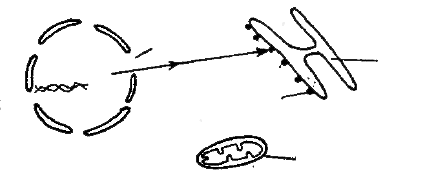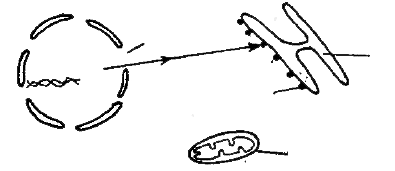Complete Solutions to REVIEW QUESTIONS of chapter CELL - THE UNIT OF LIFE of Class 11 book with complete answers and questions
| Class 11 | BIOLOGY |
| Chapter | CELL - THE UNIT OF LIFE |
| S CHAND | REVIEW QUESTIONS |
| Number Of Questions | 52 |
| Academic Year | 2023-24 |
In which organelle will you find
chlorophyll
View SolutionIn which organelle will you find
zymogen granule
View SolutionIn which organelle will you find
phosphatase
View SolutionIn which organelle will you find
9+0 arrangement of microtubules
View SolutionIn which organelle will you find
tannin or latex
View SolutionLabel various paris of a cell

View SolutionGiven below is a diagram of a cell under compound microscope :

Give one reason why you would call this cell, an animal or a plant cell.
View SolutionGiven below is a diagram of a cell under compound microscope :

Give one reason why you would call this cell, an animal or a plant cell.
View SolutionGiven below is a diagram of a cell under compound microscope :

Give one reason why you would call this cell, an animal or a plant cell.
View SolutionGive below is a diagram of an animal cell showing the path of protein produced :

Identify the organelle A.
View SolutionGive below is a diagram of an animal cell showing the path of protein produced :

Identify the function of organelle B with reference to part A.
View SolutionGive below is a diagram of an animal cell showing the path of protein produced :

Identify the organelle A.
View SolutionWhich part of a cell performs each of the following functions :
Controls what enters and leaves the cell.
View SolutionWhich part of a cell performs each of the following functions :
Contains information innerited iron the cell that produced it.
View SolutionWhich part of a cell performs each of the following functions :
Releases energy by oxidising sugar.
View SolutionWhich part of a cell performs each of the following functions :
Breaks down toxic hydrogen peroxide.
View SolutionWhich part of a cell performs each of the following functions :
Digests the cell organelles during cell starvation.
View SolutionThe following list contains three cells and four cell organelles :

Which of the above cell would have abundance of organelle E?
View SolutionThe following list contains three cells and four cell organelles :

Which of the above cell would have abundance of organelle E?
View SolutionThe following list contains three cells and four cell organelles :

Name one organelle not mentioned in the list above that will be present in cell a and not in cell b.
View SolutionThe following list contains three cells and four cell organelles :

Name the organelles common to (a) cell a and b. (b) cell b and c.
View SolutionThe diagram below-shows features of an animal cell as seen under electron microscope :

Name the structure D.
View SolutionThe diagram below-shows features of an animal cell as seen under electron microscope :

Name the structure D.
View SolutionThe diagram below-shows features of an animal cell as seen under electron microscope :

Name the structure B.
View SolutionThe diagram below-shows features of an animal cell as seen under electron microscope :

What is the relationship of E and C?
View SolutionMatch the following component of the cell with that function.
(a) Nucleus
(b) Centriole
( c) Chloroplasts Function
(i) Contains genetic information.
(ii) Capture sunlight.
(iii) Plays an important role in cell division.
(iv) Produces starch.
(v) Instructs ribosomes to form proteins.
View SolutionFill in the blanks
______ separates the contents of a cell from its surrounding medium.
View SolutionFill in the blanks
Cell wall is made up ____ and is present in _____ cells.
View SolutionFill in the blanks
_______ allows exchange of substances between nucleus and cytoplasm.
View SolutionFill in the blanks
Peroxisomes help in the process of ________ in leaves.
View SolutionFill in the blanks
A nucleotide consists of ______. ______ and ______ .
View SolutionIdentify the following component of a cell :
An organelle with folding called cristae.
View SolutionIdentify the following component of a cell : Living matter of a cell
(a) Chloroplast
(b) Endoplasmic reticulum
(c) Protoplasm
(d) Mitochondria
View SolutionIdentify the following component of a cell :
Power house of a cell.
View SolutionIdentify the following component of a cell :
Component containing hereditary material.
View SolutionIdentify the following component of a cell :
Organelle containing chlorophyll.
View SolutionFill in blank with the association as mentioned in the first part:
Chloroplast : Photosynthesis
, Mitochondria : ___________
View SolutionFill in blank with the association as mentioned in the first part:
Ribosomes : Protein synthesis
, Peroxisomes : ________
View SolutionFill in blank with the association as mentioned in the first part:
Cell wall : Cellulose
, Cell membrane : ______
View SolutionFill in blank with the association as mentioned in the first part:
Mitochondria : Oxidation enzymes
, Lysosome : ________
View SolutionFill in blank with the association as mentioned in the first part:
Adenine : Thymine
, Cytosine : _________
View SolutionThe type of cell organelles that transform energy are:
(a) Chromoplasts and leucoplasts
(b) Mitochondria and chloroplasts
(c) Mitochondria and chromoplast
(d) Chloroplast and leucoplast
View SolutionThe type of cell organelles that transform energy are:
(a) Chromoplasts and leucoplasts
(b) Mitochondria and chloroplasts
(c) Mitochondria and chromoplast
(d) Chloroplast and leucoplast
View SolutionThe type of cell organelles that transform energy are:
Choloroplasts and leucoplasts
View SolutionThe type of cell organelles that transform energy are :
(a) Rough ER (ii) _______ synthesise proteins.
(b) Smooth ER (ii) ______ makes ATP.
( c) Golgi complex (iii) Digests gems and macromolecules in the cells.
(d) Lysosome (iv) Moves materials out of the cells.
(e) Mitochondria (v) Synthesise lipids
View SolutionDifferentiate between the following :
Prokaryotic cell and Eukaryotic cell.
View SolutionDifferentiate between the following :
Mitochondria and Chloroplast.
View SolutionDifferentiate between the following :
Cell membrane and Cell wall.
View SolutionDifferentiate between the following :
Chloroplast and Chromoplast.
View SolutionDifferentiate between the following :
Chloroplast and Chromoplast.
View SolutionDifferentiate between the following :
Smooth and Rough endoplasmic reticulum.
View SolutionDifferentiate between the following :
Animal cell and Plant cell.
View Solution
REVIEW QUESTIONS questions and complete solutions for chapter CELL - THE UNIT OF LIFE of S CHAND BIOLOGY (ENGLISH) of Class 11
All Exercises from S CHAND Class 11 BIOLOGY CELL - THE UNIT OF LIFE
- REVIEW QUESTIONS
- REVIEW QUESTIONS (ANALOGY TYPE QUESTIONS)
- REVIEW QUESTIONS (GIVE ONE WORD FOR THE FOLLOWING)
- REVIEW QUESTIONS (LONG ANSWER TYPE QUESTIONS)
- REVIEW QUESTIONS (MULTIPLE CHOICE QUESTIONS)
- REVIEW QUESTIONS (SHORT ANSWER TYPE QUESTIONS)
- REVIEW QUESTIONS (VERY SHORT ANSWER TYPE QUESTIONS WITH ANSWERS)